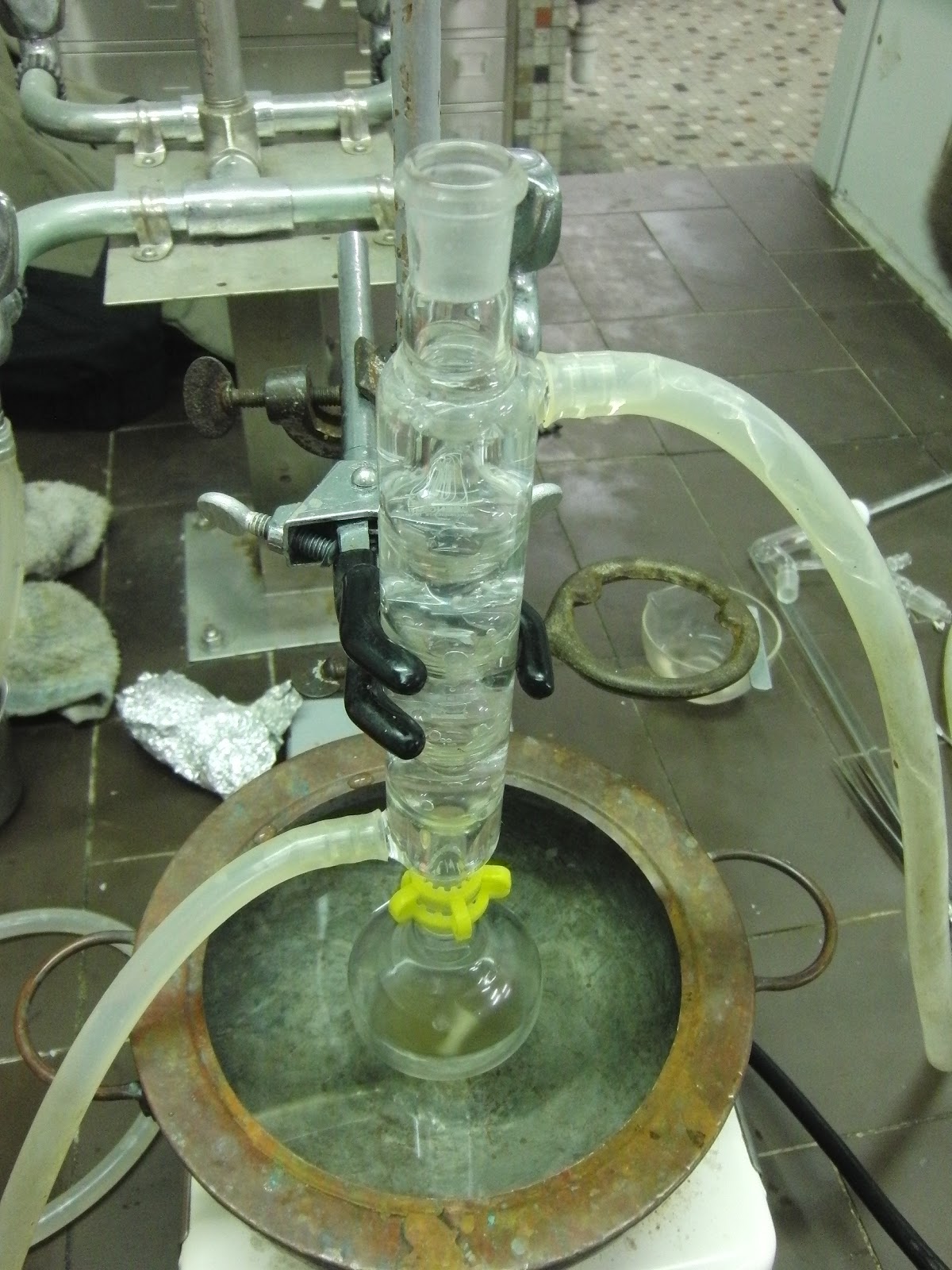The Williamson ether synthesis is an
organic reaction, forming an ether from an organohalide and an alcohol.
A Williamson Ether Synthesis consists of
two separate reactions:
1.
The preparation of an alkoxide
2.
The reaction of alkoxide with
the alkyl halide
Sodium methoxide could be prepared by the addition of sodium metal
to methanol. In the reaction, sodium metal is oxidized to sodium cations and
the hydrogen atoms of the –OH groups are reduced to hydrogen gas. A large
excess of methanol is used to act as a solvent for the sodium methoxide.
The reaction is an exothermic reaction, it would make the methanol boil.
To prevent the methanol from boiling away, we set a condenser upon the reaction
flask, called a reflux condenser. Methanol vapors condenser in the condenser
and the liquid runs back into the flask.
Because
of the vigor of the reaction, the sodium must be added slowly; otherwise, the
methanol will boil violently, overwhelm the capacity of the reflux condenser,
and spew out the top of the condenser. An uncontrolled reaction of this type,called
a runaway reaction, may erupt like a volcano, throwing flammable solvent and
corrosive chemicals over laboratory workers
andthe work area.
After
all the sodium has reacted, excess methanol is removed by distillation.
Decreasing the volume of solvent increases the rate of reaction of sodium
methoxide with 1-bromobutane and permits the entire reaction sequence to be
carried out in a single laboratory period.
Chemical
5.5g 1-bromobutane
8 g anhydrous calcium chloride
3 g 25% aqueous calcium chloride
40 mL methanol
1.4g diced sodium metal
Procedure
Step 1: Preparation of Sodium
Methoxide
1.
Place 40 mL of methanol in a 50-mL round-bottom flask and
fit the flask with a reflux condenser. Add 1.4 g of diced sodium metal through
the top of condenser, allowing the reaction to subside before adding the next
piece. If the sodium sticks to the inside of the condenser tube, push it into
the reaction flask with a long glass tube or rod.
Reflux Apparatus
Sodium Metal under Ether
Sodium is Reacting with Methanol
2.
After the sodium has completely reacted, fit the flask
for a simple distillation, put a stir bar into the reaction flask, and distil 25mL
of methanol into a graduated cylinder. If it is necessary to stop the
experiment at this point, store the sodium methoxide in the round bottom flask
with a heavily greased glass stopper.
After the sodium has completely reacted
Distill 25mL Methanol out from the mixture
The Boiling Point of Methanol
Some Sodium Methoxide Precipitate on the Wall of the Round-Bottom Flask
Step 2: Reaction of Sodium
Methoxide and 1-Bromobutane
1.
Fit the 50-mL round-bottom flask containing the sodium
methoxide with a reflux condenser.
2.
Cool the flask to room temperature with an ice bath.
Weigh 5.5 g of 1-bromobutane into a flask. Using a dropper, add the 1-bromobutane
into the reaction vessel through the top of the condenser in 1~2mL aliquots
over about a 2minute period. Although warming may be required to start the
reaction, the reaction is quite exothermic.
Sodium Bromide Precipitate from the Solvent
3.
Do not add all the 1-bromobutane in one portion. Cool the
reaction flask with an ice bath, during the addition. Cork the Erlenmeyer flask
between additions so that the
1-bromobutane does not
evaporate.
4.
After the addition has been completed, let the reaction
vessel stand at room temperature until the exothermic reaction has subsided and
the methanol ceases to reflux. Then heat the mixture at a gentle reflux, or
"simmer," for one-half hour with a heat plant.
5.
The mixture will bump because of the precipitated solid;
therefore, do not attempt a vigorous reflux.
6.
After the reflux, cool the reaction vessel with a water
or ice bath and add 4~6 mL of water to the mixture through the reflux
condenser. If all the sodium bromide does not dissolve, add a few additional
milliliters of water. Dissolving the sodium bromide prevents bumping in the next
step.
A Huge of Sodium Bromide Formed
7.
Equip the flask for simple distillation. Distil the
two-layered mixture, collecting the material that boils up to 64°C. The volume of
distillate should be about 8mL.
Add Some Water into the Mixture to Dissolve NaBr
The Clean Liquid is the Distillate of n-Butyl Methyl Ether
8.
Transfer the distillate to a 25mL separatory funnel and
extract it with three 3mL portions of 25% aqueous calcium chloride. (The
calcium chloride solution is the lower layer in this extraction, and the
interface is difficult to see.)
The upper layer is the ether
9.
Pour the product from the separatory funnel into a 25mL
round-bottom flask, add a gram of
anhydrous calcium chloride, stopper the flask, and let it stand overnight.
Here is the final product
Experimental
Record
|
Weight of n-Butyl Methyl Ether
|
2.315
g
|
|
Weight of n-Butyl Methyl Ether(Theory)
|
3.520
g
|
|
Yield
|
65.8
%
|















No comments:
Post a Comment